Text
Psoriasis - Types, Symptoms, Causes and Treatment
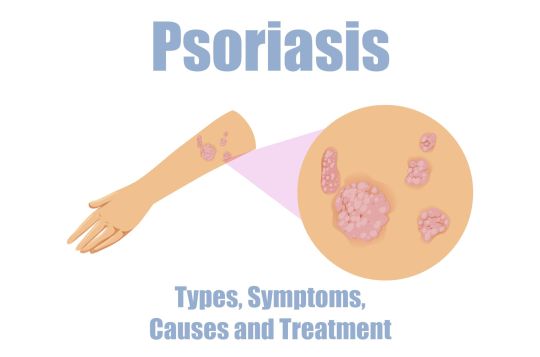
What is Psoriasis?
Psoriasis can be described as a skin condition which generally speeds up the cycle of skin cells. When someone is suffering from psoriasis cells in his skin build up in a very rapid way on the surface of the skin. It’s generally a chronic disease and comes to appear and disappear several times. In most cases psoriasis cause scales which are whitish-silver which develop into thick red patches which then eventually crack and bleed. The disease is in most cases seen on joints such as knees and elbows but in general, it can develop anywhere including feet, neck, hands, face and even scalp. Psoriasis is highly linked with other more serious conditions such as heart disease, arthritis, type 2 diabetes, and inflammatory bowel disease.
Types of Psoriasis
There are five different types of psoriasis which include:
Guttate Psoriasis – This type of psoriasis is common among children and causes small pink spots. Body parts mainly affected by the guttate include arms, legs, and torso.
Plaque Psoriasis – This is the most common type of psoriasis and it’s estimated that 80% of all the people suffering from the condition suffer from the plaque type. The plaque psoriasis causes red inflamed patched which cover most areas of the skin. It’s main witnesses in knees, scalp, and elbows.
Pustular Psoriasis – this type of psoriasis is mainly found in adults and can be identified since its causes white blisters filled with pus. It’s localized in body areas such as the feet.
Erythrodermic Psoriasis – This is a rare type but when it occurs it covered the entire body at once. It’s very serious since it comes with fever and can be very life-threatening.
Inverse Psoriasis – Patches of this type of psoriasis mainly occur under the breasts or armpits and even around the genitals.
Symptoms
Symptoms of psoriasis as not constant but differ from person to person. The symptoms also depend on the type of psoriasis one is suffering from. The most common symptoms include:
A dry skin that cracks and starts bleeding
Inflamed patches on the skin which are red in color
Whitish-silver scales
A burning sensation around the patches
Painful swollen joints
Soreness around the patches
It’s good to note that not all people experience these symptoms as some people will have totally different symptoms. In other cases, the symptoms may appear and then disappear and the disappearance does not mean that the disease is gone. However, psoriasis is not contagious and therefore the skin disease cannot be passed to another person.
Causes
The exact cause of psoriasis has never been identified and doctors are still researching about it. It’s however believed that it’s caused by two main factors which are:
Immune system – This disease is an autoimmune one. Being an autoimmune means that it’s caused by the body attacking itself. The main cause is believed to be as a result of T cells which are part of the white blood cells attacking the skin cells.
Genetics – Psoriasis can be passed from generation to generation and therefore there is a possibility of inheriting genes which are likely to develop into the disease.
Diagnosis
There are two main examinations that can be used to diagnose psoriasis:
Physical examination - Through simple physical exercise doctors can diagnose psoriasis since most of the symptoms are evident. During this examination, the patient is required to show the doctor all the areas of concern.
Biopsy - Biopsy is applied when the symptoms are not clear and involves taking a sample of the skin. The sample taken is then taken to the lab and is given a closer attention using a microscope.
Triggers of Psoriasis
Psoriasis has different triggers and in most cases, the triggers depend on the immune system of the affected person. Here are some of the triggers:
Alcohol – Heavy drinking can trigger the occurrence of psoriasis
Stress – In most cases stress has been seen to trigger the flare up. It’s therefore advised to manage your stress
Some medications – There are medications such as lithium and high blood pressure which are also seen to trigger.
Other possible triggers are infection and injury.
Recommended Diet
The type of food and your general diet can help reduce the symptoms of psoriasis even though they cannot cure the disease. Here are some of your dietary recommendations:
Take heart-healthy diets – To reduce the symptoms you are required to stop taking saturated fats. It’s therefore good to take foods containing omega 3 fatty acids like shrimp and salmon. Other recommended intakes include flax seeds, soybeans, and even walnuts.
Avoid foods such as red meat, refined sugar, dairy products, and processed foods since they are triggers.
Take foods with a lot of vitamins so that you can generate enough nutrients.
Drink less alcohol or even stop drinking completely
Treatment
The cure for psoriasis has not been found and therefore medication is done to reduce scales and inflammation. The treatment is categorized into three:
Systematic medication – This is simply injected and oral medication and is done to people who haven’t responded well to the other types of medication. The medication includes retinoid, biologics, methotrexate, and Sandimmune.
Topical treatments – In this treatment use of creams as well as ointments are recommended. Some of the treatments include topical retinoids, topical corticosteroids, moisturizer, anthralin, and salicylic acid.
Light therapy – in this case, the use of natural light or even ultraviolet light is used. The light is used to kill the white blood cells which are overreacting.
Medication
Some of the most recommended medications for psoriasis include:
Retinoids which reduce the productions of skin cells.
Cyclosporine - this medication stops the response of the immune system and therefore controlling the white blood cells.
Biologics – This medication changes your immune system, therefore, reducing the chances of interaction between inflammatory pathways with your immune system.
Methotrexate – this medication is very useful in the suppression of the immune system. This medication is however known to have side effects like liver damage when used for a long time.
Image Credits
Designed by brgfx / Freepik
Read the full article
#Biologics#Biopsy#Cyclosporine#ErythrodermicPsoriasis#GuttatePsoriasis#Immunesystem#InversePsoriasis#Lighttherapy#Methotrexate#PlaquePsoriasis#Psoriasis#PsoriasisSymptoms#PustularPsoriasis#RecommendedDietForPsoriasis#Retinoids#Systematicmedication#Topicaltreatments#TriggersofPsoriasis#TypesofPsoriasis#WhatisPsoriasis
0 notes
Text
The Best Autism and Aspergers Quotes


“Autistic today. Genius tomorrow.”

“Autism is not contagious, but my smile is.”

“If you’ve met one person with autism, you’ve met one person with autism,” Dr. Stephen Shore.

“Stop thinking about normal…You don’t have a big enough imagination for what your child can become,”

“English is my 2nd language. Autism is my first,”
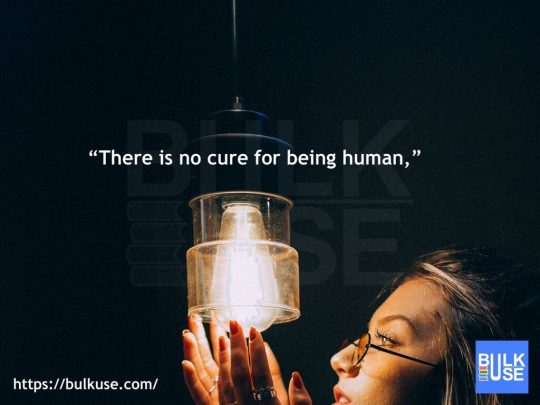
“There is no cure for being human,”

“My autism is like the taste of tepid saké, different but interesting,”

“It seems that for success in science or art, a dash of autism is essential.”

“Even for parents of children that are not on the spectrum, there is no such thing as a normal child.”
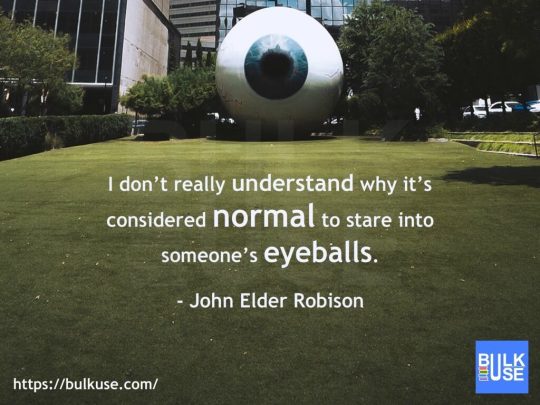
“I don’t really understand why it’s considered normal to stare into someone’s eyeballs.” — John Elder Robison

“Why fit in when you were born to stand out?” — Dr. Seuss
You Check More Autism Quotes Here
Read the full article
0 notes
Text
Do you have Hay Fever? or Confused with other Conditions?
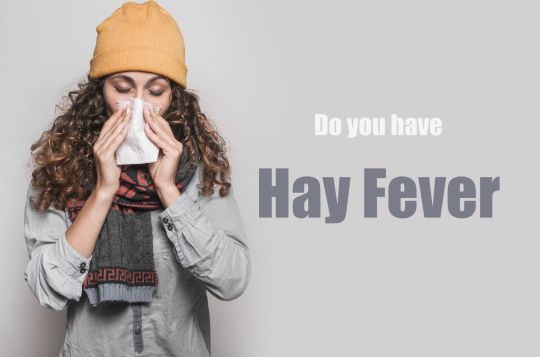
Allergic Rhinitis / Hay Fever
Allergic rhinitis, otherwise known as hay fever. It strikes about 7.8% of people in the US over the age of 18 years, and about 10%-30% of people worldwide. It is an allergy to pollen and dust that causes itchy and inflamed mucous membranes of the eyes and nose. A runny nose as well as watery eyes are a common manifestation of this irritating condition.
Hay fever itself is generally not dangerous, but it can trigger allergic asthma if it continues untreated. Hay fever is commonly confused with other conditions, so it is best to make a visit to your physician if you are unsure whether your symptoms are from hay fever or something else.
Cold

Image Credits : Designed by Freepik
The common cold is often hard to distinguish from hay fever. Both can give similar symptoms. Sneezing, a runny nose, and coughing can all be caused by both colds and hay fever.
They are brought on by different reasons, however. Cold symptoms happen when your body launches an attack against an invading virus. Colds are contagious and you can get them from being around others who have the virus, whereas allergies are not contagious and you cannot catch allergies from another individual.
Hay fever is caused by an overactive immune system which mistakes harmless substances such as pollen and dust to be germs, and then your body launches an attack on them. If you are unsure whether your symptoms are caused by allergies or a cold, you may have to wait it out and see. If the coughing, runny nose and sneezing persist beyond two weeks, then it is likely allergies and not a cold that you are dealing with.
Hay fever may disappear with time as well, but it generally takes longer, and can be seasonal. As long as you are in contact with the allergy trigger, then you will continue to display symptoms.
Another way to distinguish between the two is that a cold will not give you the symptom of itching. If you feel itchiness in your ears, nose, mouth or throat then it is likely that you have allergies and not a cold. On the other hand, if you have aches and fever along with your other symptoms, this is more likely a cold than hay fever.
Asthma

Image Credits : Designed by luis_molinero / Freepik
Asthma is another condition that can sometimes be confused with hay fever. Hay fever and asthma are completely different from one another, but are very much linked and have an effect on each other, which determines how you should react if you have one of them.
When an individual has both of these, hay fever will almost always make the asthma worse if it is not controlled properly, and it can bring on an asthma attack. If you have hay fever, be sure to speak with a doctor in order to get the condition under control, so that it will not cause or exacerbate other issues such as this.
Hay fever is common, and there are many ways that a person can have it treated and bring it under control. The symptoms can be confused with various other conditions, so do what you can to find out whether they are from hay fever or something else. With proper treatment, you can make hay fever take a more minimal role in your everyday life.
Read the full article
0 notes
Text
Lung Cancer - Types, Stages, Symptoms & Treatment
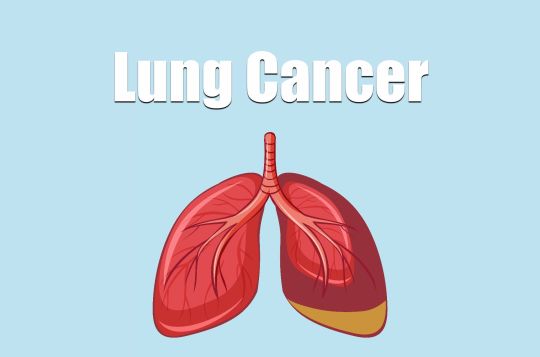
Cancer and Lung Cancer
Cancer can be described as a collection of related diseases. It starts when somebody cells start dividing without a stop and therefore spreading to other tissues. Cancer can start at any part of your body. In this article, we will concentrate on lung cancer. Lung cancer is simple cancer which starts in a person’s lungs. In the lungs, the most popular which is also a very popular type of cancer is the non-small cell lung cancer (NSCLC) and makes up to 80% of all cases of lung cancer cases related. 3 In addition, 30% of all cases of lung cancer are reported to start at the outer parts of the lung.
Small-cell lung cancer (SCLC) is also responsible for about 15% of the reported cases of lung cancer. It’s good to know that NSCLC spreads at a slower rate when compared to SCLC.
Types of Lung Cancer
There are three main types of lung cancer
Non-small cell lung cancer
Small-cell lung cancer
Mesothelioma – Mesothelioma is a type of lung cancer which is mainly associated with exposure to asbestos. This type of cancer is very aggressive even though it said to be rare. Its main cause is asbestos and its symptoms are chest pain and blood coughing. It can, however, be treated through chemotherapy, surgery, and radiation.
Stages of Lung Cancer
The stages of lung cancer depend on how far it has spread. It’s good to know that the chances of treating cancer are higher when the disease is detected in its early stages.
The NSCLC Has Five Stages Which Are:
One: In this stage, cancer has been detected in the lungs but has not spread to other parts of the body
Two: In this stage, cancer has gone past the lung as well as lymph nodes.
Three: Here cancer is now in the lung, lymph nodes as well as the chest.
Three A: In this stage, the cancer is found in lymph nodes and in the side of the chest where it started
Three B: Cancer is found in lymph nodes and the opposite side of the chest
Four: In this stage, cancer is spread on both sides of lungs as well as all areas around the lungs
The SCLC has two stages:
Cancer is found on one lung
The stage where cancer has spread in an extensive manner. In this stage, cancer has spread throughout one lung or to the opposite lug or to the fluids around lungs and even to lymph nodes on opposite sides.
Symptoms
All lung cancer symptoms are basically the same. The early symptoms include:
Very serious and worsening cough
Coughing blood
Chest pains which tend to be more painful when you take a deep breathe
Fatigue as well as general weakness
Weight loss and loss of appetite
Wheezing
Respiratory infections such as pneumonia
In later stages symptoms include
Yellowing of eyes as well as the skin
Balance issues and dizziness
A continuous headache
Bone pains, ribs pain and hips pain
Vomiting
Nausea
Confusion
Seizures
Coma
Fluid retention
High blood pressure
Causes of Lung Cancer
Anyone can get lung cancer but most of the cases reported are as a result of smoking. From the moment one starts smoking they start damaging the lung tissues. Lungs fight hard to repair the damaged tissues but with continued smoking, the lungs are overpowered. With the cells damaged they stop operating normally and this creates a route for lung cancer.
Lung cancer can also be caused by the exposure to radon which is a natural radioactive gas. Other substances associated with lung cancer include cadmium, arsenic, uranium and even some petroleum products.
Risk Factors
The biggest risk factor associated with lung cancer is smoking. This is because tobacco has many toxic substances and therefore smoking increases the chances of lung cancer. Secondhand smoking can also lead to lung cancer. Many people who never smoke have died because of exposure to secondhand smoking. Exposure to radon also increases the chances of lung cancer. Exposure to asbestos is equally dangerous. Other factors include radiotherapy previous done on your chest area and even family history of lung cancer.
Diagnosis
The first thing is physical examination after which the doctor will prepare you tests such as:
Imaging tests such as MRI, PET scans, X-ray and even CT scans.
Sputum Cytology – This happens in cases where the patient produces phlegm during coughing and can be used to detect cancer cells.
Needle – During tests, a need can be inserted through the chest into the lung tissue. This needle is mainly used to test lymph nodes.
Bronchoscopy – this is a lighted tube that is dropped through the throat all down to the lungs which allow for closer examination
Home Remedies
Home remedies cannot be used to cure cancer. This means that home remedies can be used to divert attention or even reduce pain. Some of the home remedies include:
Massage
Hypnosis to help you relax
Yoga to help you breath better
Meditation
Acupuncture
Foods to Eat When You Have Lung Cancer
During your treatment phase, you require a healthy weight. It's therefore good to eat foods that will give you the important nutrients required by your body. Some of the foods include:
Low-fat dairy products, protein-rich foods in order to repair your tissues and body cells. In addition, eat whenever you have an appetite and this could mean eating small throughout the day. Some of the foods include eggs, lean meat like chicken, soy foods, beans, and even nuts. You are also required to take a lot of fruits and vegetables.
The preparation of these foods must be done well to avoid all forms of bacteria. In addition, make sure you eat foods rich in fiber. Lastly stay hydrated as much as you can so drink a lot of fluids.
Treatment
Before starting treatment it’s very important to seek opinions from different doctors. These doctors may include a thoracic surgeon, pulmonologist, a radiation oncologist and a radiation oncologist. Treatment depends on the different stages.
Stage 1 of the non-small cell lung cancer – In this case, a surgery to remove the affected part is recommended. Chemotherapy can also be done
Stage 2 – In this stage, if your lung is fully affected you may require surgery to remove all of it. Chemotherapy is also recommended in this stage
Stage 3 – Here you need a combination of surgery, chemotherapy and even radiation treatment
Stage 4 – In this stage, it’s very hard to treat. However here you can use a combination of surgery, chemotherapy, radiation and even immunotherapy.
Read the full article
#Cancer#fivestagesofNSCLC#LungCancer#LungCancerFoods#LungCancerHomeRemedies#LungCancerofDiagnosis#LungCancerTreatment#NSCLC#SCLC#StagesofLungCancer#TwoStagesofSCLC#TypesofLungCancer
0 notes
Text
Facts and Causes of Autism
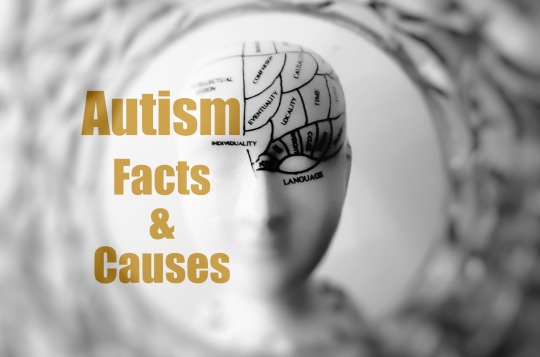
Before we get into the details of causes of Autism, let us understand some facts that surround this disorder. Here are the some facts of children with autistic disorder.
Autism Facts
- According to the current estimate, every one child out of 59 births is said to have Autism.
- Close to 85% autistic adults are unemployed.
- It is most common among boys than among girls.
- ASD is common among all groups, races of society.
Causes
Yes, as a parent of an autistic child, we want to know the causes of Autism. This is the random question asked to every doctor on hearing that their child is Autistic. Most of them think autism is caused by genetic and doctors say there are several other genes (that cause autism) which they are yet to locate. They are also caused due to environmental trigger.
Environmental Factors

Studies have shown that autism is also possible due to environmental factors. For instance; toxins and pollution around us could be a reason for a child to be autistic. These are research made in small towns based on the toxins released from industries across the belt of such towns. This has caused pollution that has resulted in the rise of autism cases.
Vaccination & Mercury
There is a belief that autism was the result of a vaccination named Thimerosal. This is because autism was diagnosed at the time when vaccination was given. However, as the research went much deeper, it was told there were no proof to show any relation between the two, vaccination and Autism.
An amount of mercury is present in vaccination. However, studies show that high levels of Mercury could also cause autism in children. Hence, the belief that autism was caused due to Vaccination. The fact remains that usually a very small amount of mercury or thimerosal is present in vaccination and this does not cause autism.
Mercury is emitted through industrial waste or by consuming plenty of fish (as mercury content is high in fish). As a result of these studies, pregnant women and their babies are tested for mercury content in their body system. This can ensure proper monitoring of the babies.
Here is a list of other causes that has come to light due to deeper studies.
- Autism could be caused due to underlying health issues.
- Diseases such as congenital rubella, fragile X syndrome, metabolic imbalance also cause autism.
Earlier, mothers were pointed for a child to be autistic; they were blamed for not dedicating enough time, love, care, and affection towards the child. In some cases the parents were blamed for bad
parenting. Doctors thought an emotional trauma could also be one of the causes. However, as time paved way for more research these theories were proved wrong. There is no definite theory against why autism is caused. Doctors are yet to investigate on this factor to analyse the right cause that is relatable and also find a better cure for the Childs growth and support in the society.
Read the full article
#ASD#autism#AutismFacts#Causes#causesofautismspectrumdisorder#congenitalrubella#EnvironmentalFactors#fragileXsyndrome#Mercury#Vaccination#Bulkuse_Official
0 notes
Text
Allergy - Types, Causes, Signs and Symptoms

Allergy
Sneezing isn't always the indication of a cold. In some cases, it is an allergic reaction to something within the air. Health specialists appraise that more than 35 million people suffer from upper respiratory tract symptoms, that are allergic responses to airborne allergens.
Pollen allergy, commonly called hay fever, is one of the foremost common chronic diseases Worldwide; airborne allergens cause the foremost issues for individuals with allergies. In general, allergic diseases are among the major causes of sickness and disability.
What is Allergy?
Allergies stem from an unseemly response of the immune system to certain proteins. These proteins are known as allergens, and they are usually common and safe substances such as dust, mold spores, various foods, insect venoms, or medications. The immune system is a complex system. When individuals with allergy diseases are exposed to common natural substances such as house dust mite, a sort of white blood cells produce particular antibodies known as IgE against that substance. This IgE at that point attaches itself to another sort of white blood cells and when the mast cells come into contact with that substance again, they start a complex immune reaction that leads to the hypersensitivity.
Types of Allergy
It is imperative to work together with your healthcare provider to form a plan to oversee your sensitivity. Maintaining a strategic distance from your allergens is the perfect way to anticipate an allergic reaction. There are numerous types of allergies. A few hypersensitivities are regular and others are year-round. A few allergies may be life-long.
Latex Allergy
Food Allergy
Insect Allergy
Pollen Allergy
Pet Allergy
- Latex Allergy
An allergic response is an anomalous reaction of the immune system to an ordinarily harmless substance. The function of the immune system is to discover foreign substances, such as viruses and bacteria, and get rid of them. Ordinarily, this reaction ensures us from perilous maladies. Individuals with a sedate hypersensitivity have an over-sensitive immune system. Their safe system responds to the drug as if it were a trespasser.
- Food Allergy
There are two categories of Food Allergies.
Immunoglobulin E (IgE) Mediated Food Allergy:
Indications result from the body’s immune system making the antibodies called Immunoglobulin E (IgE) antibodies. These IgE antibodies respond with certain nourishment. The IgE mediated food allergies most common in newborn children and children are eggs, milk, peanuts, tree nuts, and wheat. The allergic response can include the skin, mouth, eyes, lungs, heart, intestine and brain. A few of the side effects can incorporate:
Stomach pain, diarrhoea and vomiting
Swelling of the lips, throat or tongue
Shortness of breath and wheezing
Skin rash, hives and itching
Non-IgE Mediated Food Allergy
Most symptoms of non-IgE mediated food allergies include the digestive tract. Symptoms may be heaving and loose bowels. The symptoms can take longer to create and may last longer than IgE mediated allergy indications. In some cases, a response to a food allergen happens up 3 days after eating the food allergen.
- Insect Allergy
Numerous individuals think of warm climate when they think of insect sensitivities. Warm climate does signal the entry of a few undesirable visitors like stinging and biting insects. In any case, you'll be able to discover two exceptionally common “bugs” all year long in homes and buildings. Not one or the other one should bite or sting you to cause an allergic response, but both triggers hypersensitivity and asthma in numerous individuals.
- Pollen Allergy
Pollen is one of the foremost common triggers of seasonal allergies. Numerous individuals know pollen hypersensitivity as “hay fever. In spring, summer and fall, plants discharge tiny pollen grains to fertilise other plants of the same species. Most of the pollens that cause allergic responses come from trees, weeds and grasses. These plants make little, light and dry pollen grains that travel by the wind. Grasses are the foremost common cause of hypersensitivity.
- Pet Allergy
Allergies to pets with fur are common, particularly among individuals who have other hypersensitivities or asthma. Individuals with dog allergies may be touchier to a few breeds of dogs than others. A few individuals may be allergic to all dogs. Individuals may think certain breeds of dogs are “hypoallergenic,” but a really non-allergic puppy or cat does not exist.
Most Common Food Allergies
Any food can cause an unfavourable response but the most common food allergies are:
Fish
Soy
Egg
Milk
Peanuts
Shellfish
Wheat
Tree nuts
Certain seeds, including sesame and mustard seeds, moreover are common food allergy triggers and considered a major allergen in a few nations.
Causes of Allergies in the body
Everyone has antibodies in the body. The antibody which causes an allergic reaction is called IgE. In an allergic individual, the immune system's IgE can't tell the distinction between threatening and non-threatening protein substances. The first time you're exposed to a particular allergen, your body produces large amounts of IgE antibodies to work against that allergen. The antibodies join themselves to the cells containing histamine. After a rehashed introduction to the allergen, inevitably the histamine will be discharged in effective amounts, causing an invasion of hypersensitivity symptoms. While histamine is a critical chemical within the body, it can cause issues on the off chance that it is discharged within the wrong circumstance. Allergy symptoms are the body's attempt to remove a substance it perceives to be dangerous.
Sign and Symptoms of Allergy
The signs and symptoms of airborne hypersensitivities are recognisable to many. Symptoms of an allergic response may include the skin, the gastrointestinal tract, the cardiovascular system and the respiratory tract. Some of them are as follow:
Sneezing, frequently with a clogged or a runny nose
Watering eyes
Conjunctivitis
Itching eyes, throat and nose
Shortness of breath
The pale or blue coloring of the skin
Allergic shiners like dark circles beneath the eyes caused by expanded bloodstream close the sinuses
Risk Factors
Risk factors for sensitivity can be set in two common categories, namely host and environmental factors. Host components incorporate heredity, sex, race, and age, with heredity being by far the most noteworthy. However, there have been later increments within the incidence of allergic disorders that cannot be clarified by genetic factors alone. Four major environmental candidates are modifications in the introduction to infectious illnesses amid early childhood, environmental pollution and allergen levels. The inclination to have allergic reactions or atopy is acquired. In case you have got 2 parents who are atopic, your chance of being atopic is 75%. The risk goes down to 50% in the event that you have got 1 atopic parent, and to 15% if neither of your parents is atopic. Environmental factors also have a part in deciding whether or not an individual gets to be atopic, and research is proceeding to decide whether there's anything that can be done to anticipate an individual from becoming atopic.
Who Gets Allergies?
Anybody can get allergies at any age. You could develop them as a child; otherwise, you might not have any symptoms until you’re an adult. Allergies run in families. On the off chance that your parents have allergies, you likely will, as well. If parent is allergic, your chances go up. In both cases your chances are more than double. In case neither parent is allergic, there’s still a little chance you’ll get. You've got to have an inclination and be exposed to an allergen before you create hypersensitivity. The more intense the exposure is, the more frequently you come into contact with the allergen. Most individuals who develop adult-onset allergies usually do so in their twenties and thirties, in spite of the fact that it's possible to develop them at any age.
How Allergy is diagnosed?
There are a few investigations that can be useful in patients with allergic infection:
Skin Prick Test
Blood Tests
Radioallergosorbent test (RAST)
Skin Prick Test
Skin prick tests against a wide variety of allergens are profoundly touchy and are the first line test to decide what allergens a patient is allergic to.
Blood Tests
Serum eosinophilia is regularly observed in patients with allergic disease.
Total serum IgE levels are elevated within the majority of patients with allergic infection.
These blood tests are not always diagnostic, but they can be valuable to determine the seriousness or severity of the allergic tendency.
Radioallergosorbent test (RAST)
Radioallergosorbent tests (RAST) identify serum levels of allergen-specific IgE. It is utilised when the history and skin prick test results are clashing, when skin prick testing cannot be performed, or when desensitisation is being considered.
Treatment For Allergies
Common types of allergy medicine incorporate antihistamines, decongestants, and corticosteroids. Specific sensitivity medicines are frequently tailored to particular allergic disease, especially skin inflammation, allergic rhinitis and asthma. There are, however, a few common treatment standards:
- Allergen Avoidance
With any allergy, your first method of treatment ought to be to avoid the offending allergen. Try to avoid the areas where allergens are in high concentration e.g. the stop in springtime where hay fever causing pollens are in high concentration or maintaining a strategic distance from cats or dogs. One of the most focuses on allergen evasion ought to be your bed and bedding. In case you're allergic to dust mites, your bedding is crucial. There's nothing more regrettable for an allergy sufferer than breathing in dust mite allergens all night long. Since dust is a major culprit in indoor hypersensitivities, it's also vital to keep your home exceptionally clean. Running a dehumidifier inside can moreover be a supportive strategy of allergen avoidance, as overly humid air is good for both mold spores and dust vermin, two common allergens.
- Allergy Medications
Adrenaline incorporates a role in extreme allergic reactions such as anaphylaxis. Antihistamines block the impacts of the histamine that is ordinarily discharged during an allergic reaction. Common antihistamines incorporate a few over-the-counter drugs like Benadryl, Claritin, and Triaminic. Stronger, prescription drugs like Allegra can soothe symptoms like sniffling and itching, nasal swelling, and runny noses. Anti-inflammatory medicines designed to decrease the overzealous immune reactions seen in allergic infection, such as topical corticosteroids have a part in eczema, allergic rhinitis and asthma. Decongestants can be utilised to soothe sinus-related allergy symptoms like a stuffy nose. They are commonly utilised in nasal spray decongestants.
- Allergy Desensitisation
Desensitisation isn't appropriate for all allergic infections. It is especially valuable for insect stings and drug allergies, where it is usually viable but less valuable for asthma or allergic rhinitis, where it is less successful. It is most valuable where there are a small number of hypersensitivities, such as only insect stings, and less valuable when there are multiple allergies.
Natural and Home Remedies to Treat Allergies
Feeling like allergies are getting the finest of you? You’re not alone. Particularly during the spring and summer, allergies can be overwhelming and make life fantastically awkward. Fortunately, allergy sufferers can find significant alleviation from natural remedies.
- Exercise or Workout
Exercise plays a key role in treating allergies. It produces an anti-inflammatory impact in your nasal passages, helping to normally diminish allergy symptoms. If dust counts are greatly high, an indoor workout will most likely be more beneficial because it will decrease re-exposure.
- Probiotics
Probiotics give the immune system a boost by introducing advantageous microbes into your digestive tract. A good source of the probiotics can be found in fermented foods, like kimchi. Kombucha is another extraordinary source of probiotics.
- Honey
Tragically, you can’t basically tell your body that grass and dust aren’t awful for it. But you can help your body learn that the local habitat isn’t dangerous. You do so by giving your body little dosages of the grass and dust that are aggravating it. This is where local honey comes in so helpful. Bees make their honey from what’s around. Thus, their honey contains trace amounts of the pollen that might be making you are feeling wiped out.
- Bee Pollen
Like honey, bee dust contains the natural substances where the bees live. It offers an elective way to introduce these substances to your immune system. Since sometimes we all need to include a little variety to our diets. Great sprinkled on the natural product or tossed in the salad, it offers a bit of a sweet crunch.
Foods to Take and Avoid
Some foods can make symptoms way better, and a few can make them more awful.
- Foods to Take
Hot drinks and soup, fish, fruits and vegetables, yogurt, nuts and healthy oils help control different types of allergies.
- Foods to Avoid
Raw fruits and vegetables should be avoided.
Allergy Prevention
Managing and preventing hypersensitivities can be tough but by utilising a few of these allergy prevention tips, you can move toward an allergy-free life. Massage can diminish symptoms by improving circulation, reducing anxiety and releasing muscle pressure. Good and dry ventilation, dry and clean dress storage within the closets and expulsion of damps from the house helps avoid sensitivities from molds. Exposure to the good probiotic bacteria in the newborn child diet. Consideration of the vitamins C and E, and omega-3 polyunsaturated oils in your diet.
Image Credit
Designed by Evening_tao
Read the full article
#Allergen avoidance#allergies#Allergy#AllergyDesensitisation#AllergyMedications#BloodTests#CausesofAllergies#CommonFoodAllergies#FoodAllergy#HomeRemediestoTreatAllergies#HowAllergyisdiagnosed#Howtomanageallergies#IgE#ImmunoglobulinE#InsectAllergy#LatexAllergy#Non-IgE#PetAllergy#PollenAllergy#Radioallergosorbenttest#RAST#SignandSymptomsofAllergy#SkinPrickTest#TreatmentForAllergies#TypesofAllergy#WhoGetsAllergies
0 notes
Text
Know About School System For Special Children Like Autism

Autistic children will have special needs when it comes to schooling. Many children with Autism go to public school and do just fine with some special modifications. There are laws pertaining to kids with disabilities. Here are some of the things you will need to know about Autism and school.
The Individuals With Disabilities Act

The Individuals with Disabilities act was passed to make sure all children receive a free and appropriate public education that meets their needs. The act requires children with special needs to have special education service as long as they meet the requirements. Autism meets that requirement.
Free and Appropriate Education

This is an education that meets the special needs of your child. It is one that allows them to make progress learning.
Least Restrictive Learning Environment

This means that your child will be placed in an educational setting that is right for their special needs while allowing them to socialize with kids that do not have a disability. The school will do what it can to meet the needs of your Autistic child while keeping them in regular classrooms.
To figure out what special needs your child will need the school will evaluate your child. This evaluation can be requested by the school or the parent. If you think there is a problem write a letter to the school asking them to evaluate your child. They will send a paper home for you to sign that gives permission for the evaluation to take place. During the evaluation your child will be tested for learning disabilities along with any mental, or behavioural problems. After the evaluation is complete the school will have a meeting with you to discuss their findings, and what can be done to help your child.
IEP

An IEP is used when a child has a need for special education services. The group that evaluated the child will be part of the team that creates the IEP. The parents will also have a say in what is included in the IEP. An IEP will state the needs the child has to get an appropriate education.
They will also list the services the child is going to receive in the IEP. The IEP can be evaluated at any time if the services are not working for the child. An example of some services that might be included in an IEP are extra time when completing class work, have tests read aloud to the child, or an aide is provided for the child.
Each IEP will be different for each child. The IEP will be evaluated on a yearly basis unless the parents request it sooner. The parents have the right to be at every IEP meeting held.
You are your child's best advocate when dealing with the school system. Some schools will try to give you the run around. They will do whatever they can to keep your child from having any special services in school. You have to be the one to stand up for your child. You are their voice. If you do not feel comfortable dealing with the school alone there are lawyers and advocates that are there to help.
Read the full article
#AppropriateEducation#DisabilitiesAct#education#IEP#LearningEnvironment#school#schoolsystem#Bulkuse_Official
0 notes
Text
Cold - Signs and Symptoms, Causes, Home Remedies

Common cold which is in simple terms called Cold is a disease caused by virus mainly affecting the upper respiratory tract with its main targets being the nose, sinuses, through and even larynx. There are different ways you can know that you are having a cold like having a runny nose, nonstop sneezing as well as scratchy throat. However, people see common cold as a mystery since it affects people differently. When exposed to the same conditions to another person you may get cold while that person remains very healthy and this mainly depends on the strength of your immune system. Cold is caused by a virus with the most common virus being rhinovirus which is responsible for more than 50% of all colds. Other than the rhinovirus other common viruses that cause colds, influenza, syncytial virus, and even parainfluenza.
Types of cold
There are three different types of cold. These are:
Bronchitis
Pneumonia
Sinusitis
Signs and Symptoms
The signs and symptoms of cold are straightforward, One can know they have a cold without even visiting a doctor. If you detect body changes with any of the following symptoms then cold is catching up with you:
Sore throat – Sore through will be among the first signs of cold. It is very common in the early stages of cold and other viral infections.
Cough and sneezing – Coughing and sneezing is a mechanism by your body which it uses to try to remove anything that tries to damage its airway such as pollen, dust and even virus.
Runny nose - Another sign is the presence of mucus building up in your nose. In this case, the mucus starts when it’s watery and thin but becomes thicker as the cold progresses.
Headache – Headache is mainly caused by the building up of mucus since it clogs the infected person’s sinuses, therefore, creating pressure which then leads to a throbbing headache.
Tired and weak – Feeling weak and tired is another symptom associated with most virus attacks. When your body is under attack you will not be in your usual energy since the virus will try to weaken your defense system and therefore you will remain weak and feel tired.
Causes
Cold is caused by many viruses but the most common virus is the rhinoviruses since its responsible for more than 50% of all common cold cases. As mentioned above other common viruses are influenza, syncytial virus, and even parainfluenza.
The cold virus attacks the body through nose, mouth and even eyes. The virus is spread in form of droplets when a person coughs, talks or even sneezes. It’s therefore mainly spread through the air. This cold virus can also be spread through contact with someone who is sick. The spread is through the sharing of objects like towels, utensils and even toys. After the contact with such items and then touch your nose, mouth or even eyes then you will have a high chance of getting cold.
What Age of People Get Infected?
Cold affect people of all ages. Cold is more severe to children below the age two and also dangerous to the elderly above the age of 65 years. However, people with a weak immune system can also have a problem-fighting cold because the body does not have enough defence. If a kid or an elderly person has a fever which lasts more than 3 days then you need to consult a doctor.
Risk Factors
Here are some of the factors that increase the chances of you getting cold:
Weak immune system – Having a weak immune system will increase the chances of getting cold
Age – Children under the age of 5 years have a higher risk of getting cold especially when they are exposed.
Smoking – Smokers have a higher risk of catching a cold than people who do not smoke
Time of the year – In certain times of the year like winter both children and adults are more exposed to cold
Exposure – If you stay around people who are sick like in schools you have a higher chance of being exposed
Diagnosis
In general, if you are healthy then you do not need a doctor to diagnose cold. A healthy immune system fights the cold infection and clears it within 7 days without a doctor. For a severe or persistent cold, you need proper diagnose which in most cases starts with a physical exam as well as medical history. During the diagnosis, you will be asked questions about the symptoms and how long you have experienced them. The doctor is also likely to check your through, ears, lings and even sinuses. In severe cases, a doctor is likely to do a chest x-ray to check whether there are serious complications like pneumonia.
Some lab tests can also be conducted to detect the type of virus because cold is caused by different types of virus. When the diagnosis is on a child below 2 years the doctor is likely to order viral tests. Viral teat also applies to people who have a weak immune system as well as those who are elderly.
Types of Doctors To Consult
A common cold may not be very serious to require a specialist for it. In cases of kids, you are advised to visit a doctor if your child’s fever is above 100 degrees. Doctors like physicians, internists, and even paediatricians can all help in treating cold.
Home Remedies
Here are some recommended home remedies that you can use to cure and prevent cold:
Ginger tea - Ginger tea is very good in treating common cold. The beauty of ginger tea is that it dries running nose which is basically the first step to stopping cold.
Mixture of honey, Cinnamon, and lemon – This is another very effective home remedy that you can use to cure cold. The mixture is very natural and good for the body too.
Luke-warm water – Luke-warm water is very good in reducing inflammation in the throat and therefore reducing cold.
Gargle with salt-water – This may look old school but it’s very effective in eliminating cold
Foods To Take
Foods rich in Carotene such as beef liver, broccoli, carrots, kale, pumpkin, sweet potatoes, tomatoes, watermelon, guava, beets, and even mangoes.
Vitamin E such as corn oil, sunflower seeds, peanut butter, lobster, almonds and cod-liver oil.
Foods having vitamin C such as cauliflower, broccoli, kale, orange juice, sweet potato, tomatoes, and strawberries.
Foods rich in Bioflavonoids is also good in helping you remain healthy. Research has revealed that Bioflavonoids have nutrients which are very good at busting the immune system.
Foods to Avoid
Dairy goods – when have a cold avoid dairy goods because they help in the mucus production.
Juices – Experts have advised that people should avoid juices because of the high content of sugar. In addition, juices have an acid which can be very irritating to the throat.
Fried snacks and fast foods – Fried foods as well as fast foods have ingredients which do not have any nutritional value
Caffeine – Caffeine should not be taken during cold. This is because it dries cough and therefore can lead to breathing problems during such times.
Prevention
There are different ways you can prevent catching and spread of cold. Come of them are explained below:
Disinfect your stuff – Ensure that you clean your bathroom and kitchen countertops with good disinfectants especially when a member of your family or even a friend has a cold. Ensure that your kids’ toys are washed periodically.
Wash your hands – Ensure that you clean your hands well with running water and teach your kids the importance of washing their hands
Use handkerchiefs - Every time you are sneezing ensure that you sneeze into handkerchiefs to deduce the chances of infecting other people.
Take care of yourself and family as well – Eating well, doing adequate exercises as well as having adequate sleep and managing your stress then you will manage to keep cold away.
Don’t share – Do not share glasses and other utensils with a person having cold to reduce its chances of spread.
Read the full article
0 notes
Link
Treat Fibroids With Natural Home Remedies
#fibroids #women health #health
0 notes